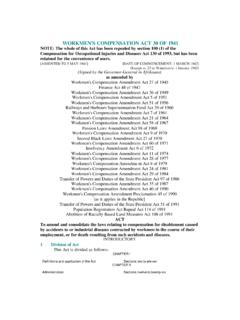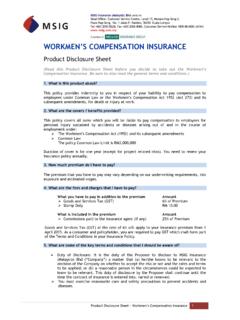Transcription of The Compensation Fund - National Treasury
1 1 The Compensation fund Preliminary Report 2nd Draft 1. Introduction The Compensation fund provides Compensation to employees who are injured or contract diseases through the course of their employment. The fund is governed by the Compensation for Occupation Injuries and Diseases Act (COIDA) of 1993 (amended in 1997) which determines how (and by whom) the fund is administered and the conditions for eligibility for Compensation . This report looks briefly at the historical context of Compensation in South Africa followed by an analysis of the current state of Compensation for occupational injuries and diseases. This includes an assessment of the industry structure, the claims process, coverage and how employer contributions are determined. In addition, an analytical discussion of Compensation is provided followed by issues for further research. 2. History of Compensation in South Africa The first Workmen s Compensation Act (WCA) was passed in 1914.
2 Prior to the passing of the act employees injured at work had to institute a common law suit against the employer for negligence. However the difficulty of proving negligence and the high cost of litigation rendered the worker s common law right minimal. Compensation would only be paid if blame could be laid directly with the employer. While the 1914 WCA only recognised injuries, amendments to the act in 1917 extended coverage to provide for specified industrial diseases. In its early form, the WCA was ineffective at providing adequate Compensation because employers were not compelled to insure their workers against the risk of workplace injuries. At the same time, firms that did not have insurance could face insolvency from a serious incident, while the employee affected could face poverty. As a result, by 1930, workers, industry and government recognised the need for compulsory insurance (Budlender, 1984).
3 As the mining industry faced a high accident rate, the Rand Mutual Assurance Company started in 1894. By 1914 half the mines belonged to this self-insurance scheme and by 1931 (when a new WC bill came into effect) all mining companies belonged to Rand Mutual. The member companies were exempted under the 1931 bill. The 1934 WCA made insurance compulsory, through private companies rather than a state fund favoured by workers and trade unions. While the 1934 WCA had increased benefits, organised labour was unhappy with the 2scheme as the premiums were too high. There were 57 insurance companies that were organised such that competition was limited. The Federated Employers Mutual Assurance Company started in 1936 in response to the situation (Budlender, 1984). In 1941, a new coalition government was formed which included the Labour Party. The political interest of industry favoured concessions to labour to gain support for the war effort.
4 As a result the 1941 WCA was passed in which all accidents were to be reported to a WC Commissioner. There were to be no more private Compensation agreements between employers and workers. Compensation would be paid from a state fund to which all employers would contribute on the basis of companies wage budgets. The 1941 Act aimed to institute a state scheme as well as increase benefits (Budlender, 1984). While there have been subsequent amendments to the 1941 Act (see Appendix 2) these amendments have not made significant changes to the fundamentals of the act. 3. The Compensation for Occupational Injuries and Diseases Act (COIDA) of 1993 (amended 1997) Despite the numerous amendments of the 1941 Workmen s Compensation Act, there remained a number of shortcomings. In 1993 the Compensation for Occupation Injuries and Diseases Act (COIDA) replaced the former WCA to address these issues.
5 Thus, while the WCA had a pay ceiling and therefore did not cover employees of higher income groups, the 1993 Act covers all employees for Compensation not just those classified as workmen . A possible reason for this is that employees (such as professionals, office workers etc) who do not do manual labour are less likely to claim for Compensation but including them with the workmen would increase the pool of funds available to pay Compensation to those workers in higher risk categories there would be cross-subsidisation of lesser-paid workers by higher-paid. In addition, the COIDA also changed from only covering widows in the WCA to cover the surviving spouse irrespective of gender. Furthermore, new developments in the labour market, especially the casualisation of works through labour brokers, meant that significant numbers of workers were no longer covered under the WCA as they were no longer directly employed by the companies.
6 Under COIDA, all types of work relationships are covered including works that have been brokered. Finally, occupational diseases under the WCA were compensated by calculating the last salary received while in employment. This meant that if a worker was diagnosed with a disease years after their employment, they would receive insufficient Compensation given the inflation rate. Whereas under COIDA (Section 67:2), if the employee is no longer in employment at the time of the commencement of the disease, his calculated earnings will be based on the earnings he would most likely to be earning if still working. Therefore if the employee is diagnosed with a work-related illness many years after their employment, their Compensation will be in line with current prices unlike the Compensation provided under the WCA. 3 The COIDA provides a system of no-fault Compensation for employees injured or who contract diseases during the course of their employment.
7 No-fault Compensation is a legal rule that an aggrieved party is entitled to Compensation without having to prove any other party was at fault for the accident. The entire structure of the Compensation scheme in South Africa is defined within the Act. Thus, who contributes to the fund , the amount of the contribution, who is covered by the fund , the type of injuries and diseases covered by the fund as well as the size of Compensation are stipulated in the Act. Furthermore, it clearly defines the procedures, the agents and their responsibilities. Any recommended changes to the Compensation scheme in South Africa would result in an amendment of the COIDA. While the COIDA is supposed to cover all workers in South Africa for work related accidents and diseases, it currently excludes domestic, informally employed, independent and self-employed workers from Compensation (Taylor, 2002).
8 It has been argued by the Compensation fund that the rationale for the exclusion of domestic workers and informally employed is that it is logistically impossible to administer. For domestic workers it is difficult to administer and monitor as there is potential for a single employee to have multiple employers. In case of an injury, the domestic worker has to take the civil route of claiming Compensation from the employer. Self-employed are excluded from the act as there is no contract of employment. Military and police as well as correctional services are generally included, except in the case of war. Mining Diseases Due to the nature of the mining industry, certain diseases are compensated under the Occupational Diseases in Mines and Works Act 73 of 1973 (ODIMWA). The diseases covered under this act are those that have been determined to have been contracted while performing risk work in mines or related works and include pneumoconiosis, tuberculosis, permanent obstruction of airways and progressive systemic sclerosis.
9 Where mining diseases are not covered under ODIMWA, the COIDA applies and Rand Mutual is liable for all diseases as specified in the Act. A report of the Commission of Inquiry into the Compensation for Occupational Diseases in the Republic of South Africa by the Department of Mineral and Energy Affairs in 1981 found that there is no reason for the separation of mineral related occupational diseases and other occupation diseases. Both ODIMWA and COIDA provide for the management of permanent, irreversible, incurable conditions while COIDA also provides Compensation for treatable conditions. As ODIMWA deals solely with these incurable conditions it provides lump sum benefits only while COIDA provides monthly payments for permanent disablement assessed at over 30% that is related to the employee s wage. 4 The current plan is the merger of the ODIMWA and the COIDA into a new act in the next three years to ensure better monitoring, reduce accidents and close gaps within social insurance.
10 There is currently a problem of claims filed with incorrect departments, double Compensation being paid, different standards between departments and lack of equity of Compensation being paid. Part of the new proposed structure is to provide integrated inspection services with labour, COIDA, UIF etc. Also the funds for Compensation within the department of Health and the CF will be merged. The success of this plan is dependent on the ability of the relevant ministers to agree and take the draft to cabinet (from the Cabinet decision taken in 1999) (Interview with Compensation fund ). Employer Registration with Compensation fund All employers are obliged to register with a carrier which is either the Compensation Commissioner of the Compensation fund or a designated mutual association. Employers are then required to provide their respective carrier with the particulars of their businesses.














